As someone who frequents many Pagan/witchcraft online groups, forums, and discussion boards, one of the most common questions I see those new to the path asking is: “how do I set up an altar?” or “what should I include on my altar?”
On the one hand, there is a fairly basic, generalized answer to these questions, which is to use the traditional Wiccan model for altar layouts that many of us will already be familiar with. This model includes particular tools of power that are associated with the God and Goddess, and are central to Wiccan-based forms of the craft. These tools include things like an athame, a wand, a cauldron, a chalice, an incense burner, as well as representations of the God and Goddess, among other things. For a brief overview of these tools check out my post on tools and correspondences in witchcraft (for a more in-depth understanding of why these tools are used, there are plenty of online resources like this one that can help you out).
Though many Wiccans and other witches follow this model, it’s only meant to be a basic guideline, and practitioners are almost always encouraged to include other sacred or ritual items on their altars as well. You’ll often find plenty of magickal and witchy things on these altars, such as coloured candles with specific purposes, crystals (which many Pagans and witches associated with certain healing or metaphysical properties), oils, sacred symbols (like the pentacle or the Celtic triquetra), and divination tools (such as tarot cards, rune stones, crystal balls, and scrying mirrors).
Other Pagans and witches do away with the Wiccan model altogether, as they find that the layout simply doesn’t work for them. Just because certain tools and representations are used by a vast number of Pagans and witches doesn’t mean that you must include them on yours.
As I mentioned in part 1 of this post on designing an effective altar, your altar is an exceptionally personal part of your practice, meaning you should only include things on it that feel right to you, and not what someone tells you to have.
When I went about setting up my altar for the first time, I did try to include a lot of the elements from the traditional Wiccan layout (even though I’m not a Wiccan myself). But as my practice developed, and I began to really find my footing, I found a lot of the things I had originally attempted to incorporate just weren’t working for me. Some things like the chalice and the athame and the bowls of water and salt just didn’t do it for me. So, I took them off my altar and gradually began replacing them with things that did. My altar today, while still maintaining some of its Wiccan influence (mainly the duality between the divine feminine and divine masculine), is very much my own, with a layout that resonates deeply with me personally and spiritually.
Designing an altar that works for you will likely involve a lot of trial and error, and may often undergo processes of deconstruction and reconstruction. While I think the basic Wiccan model can be a good starting place for beginners, particularly those that are new to spiritual practice in general (rather than just new to Paganism or witchcraft), it’s also important to recognize that this is just an example, and you shouldn’t feel compelled to stick to the model or have every part of it (especially if you’re not a Wiccan).
There are plenty more things that go beyond the traditional model that you can include on your altar to make it unique to your own spiritual beliefs and practice. I’m of the opinion that the more personally meaningful your altar the better, as having a sense of deep connection to the objects in your sacred space will make it more effective in ritual and spellcraft.
So, here are 11 suggestions for the kinds of things you may want to think about including on your altar in order to make it more meaningful, and ultimately, more effective!
1. Representations of Meaningful Numbers
Whether you actually work with numerology or not, there is something so fundamentally powerful about numbers. As the basic building blocks of our existence, they can play a surprisingly significant role in spiritual practice and devotion. If this is something that resonates with you, then you might want to think about including numbers on your altar in some way, either by having them written out somewhere, or by grouping together things like candles, crystals, or other objects into particular sets of numbers that hold meaning for you.
For instance, like many Pagans and witches, twos and threes are especially significant in my practice. I enjoy working with various binary systems, as we often tend to think about the world in terms of oppositions. By organizing some of the candles and crystals on my altar into groups of two, I’m representing the contrast between things like the divine feminine and masculine, light and dark, sun and moon, natural and unnatural, consciousness and unconsciousness, dreams and reality. My two main working candles represent these binary oppositions, and therefore become a metaphoric representation for the duality of the cosmos.
Then, for me, the threes on my altar are meant to complicate these binaries: suggesting that the Universe is so much more than black and white, one way or the other. The presence of groups of threes also reflect things like life, death, and rebirth, or past present and future, as well as the generations of women in my family.
For many other Pagans and witches, the three is symbolic of the Wiccan Rule of Three and the Triple Goddess, and may be expressed in the three phases of the moon, or in the Celtic symbols of the triquetra and the triskele.
Think about what numbers are important to you and your spiritual beliefs or understanding of the world, and consider how you might incorporate that into your altar.
2. Representations of Personal Deities
For many Pagans, this may be an obvious one, but if you work with any personal deities, there are likely many things you can include on your altar as a means of representing and honouring them. While the Wiccan model typically represents the God and Goddess in a fairly general way, you can personalize your altar and your devotional practice further by portraying specific Gods and Goddesses.
For instance, I tend to work a lot with the Green Man archetype, particularly in the form of the Greek God Dionysus, who I represent and honour with a small statue and a goblet of wine. I also work with Hekate, Goddess of magic and witchcraft, and keeper of the keys to the Underworld, so I have various keys on my altar for her.
These representations don’t even have to be for deities you “work with,” per say, they can also simply be for those you are drawn to. If you’re drawn to death goddesses like Hel or Kali, you could include skulls or other dark imagery. If you really like the idea of the Norse God Thor, you could have a small hammer or an image from a lightning storm on your altar. The possibilities here are basically endless!
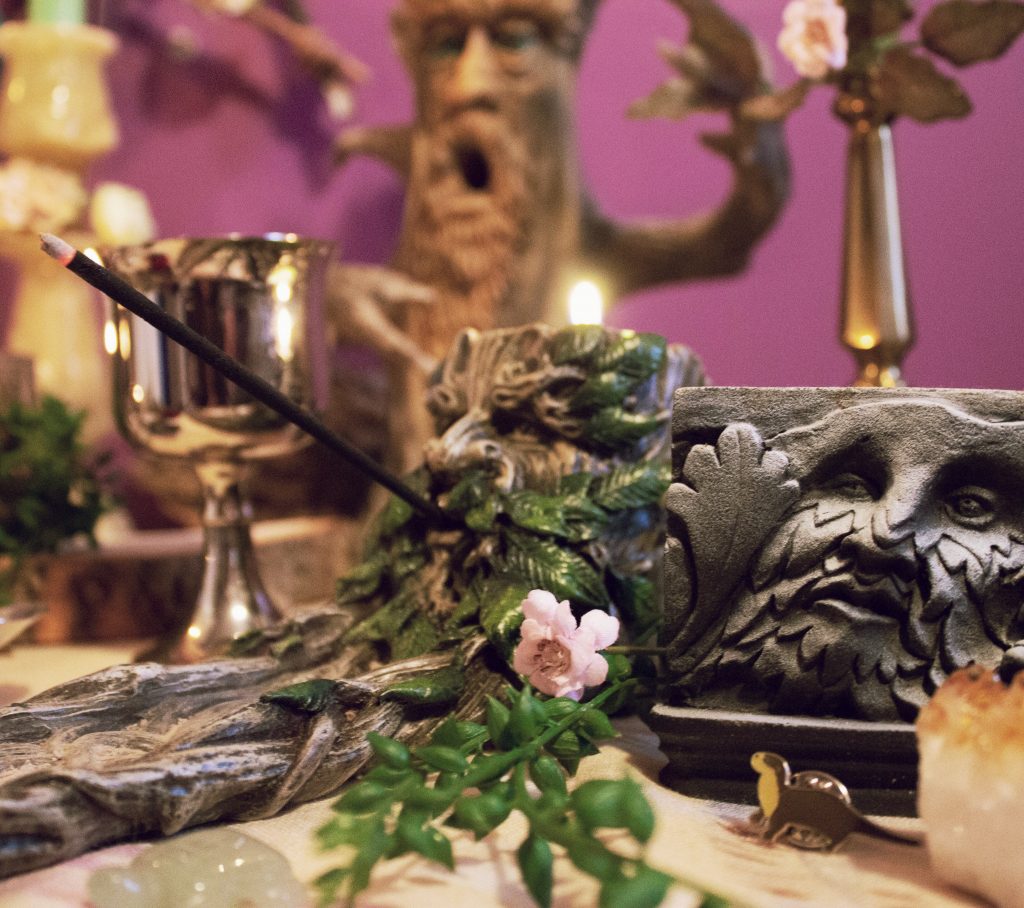
3. Things Gathered from Nature
Paganism is first and foremost a nature-based religion, and many of us like to include bits and pieces we’ve collected from outdoors in our sacred spaces, particularly when they’re taken from an especially meaningful place. Sticks, stones, tree bark, flowers, shells—anything that reminds you of your connection to nature has the potential to be spiritually significant, especially if it carries the energy or memory of a particular place.
Personally I have lots of seaglass and driftwood on my altar from my favourite shorelines in Scotland. While I was only there for a little over a year, the Scottish landscape had an incredible effect on me, and played a hugely significant role in shaping my Pagan spirituality. Now that I’m back in Canada, having a piece of Scotland on my altar is amazing, as it has become a tangible representation of the impact the land had on me.
While I was living in Scotland I also used to have a bottle of water I’d collected from the North Sea on my altar. I think it’s really cool to be able to include water from somewhere special in your sacred space, such as from the ocean, a magical creek or a fairy pool in the woods, or else has been “charged” by a particular event, like a violent thunderstorm or from being left out on the night of the full moon, or collected from the first snowfall of the season. Any of these would be great to use in ritual or spellwork, as they are infused with particular energies and meanings.
4. Things That Remind You of Loved Ones
In many ways, altars are tangible representations of the connections that are important to us: connections to celestial bodies, to deity, to the land, to the cycles of nature… and to people as well. When you’re constructing your altar, think about what objects you could include that represent certain relationships in your life, evoking connections to those that you love, whether alive or passed on.
For instance, my mother and my grandmother (now no longer with us) both love owls, so I always have a couple of owls on my altar for them. My dad used to spend his summers catching turtles as a kid, and can name any species with a glance, so I keep a small turtle on it for him.
Additionally, things that have been gifted to you by someone special are also a great way to materialize those connections, and serve as reminders of these relationships and the emotions they evoke. Within my own altar set up, a crystal rose my partner got me as an anniversary present is always a central aspect.
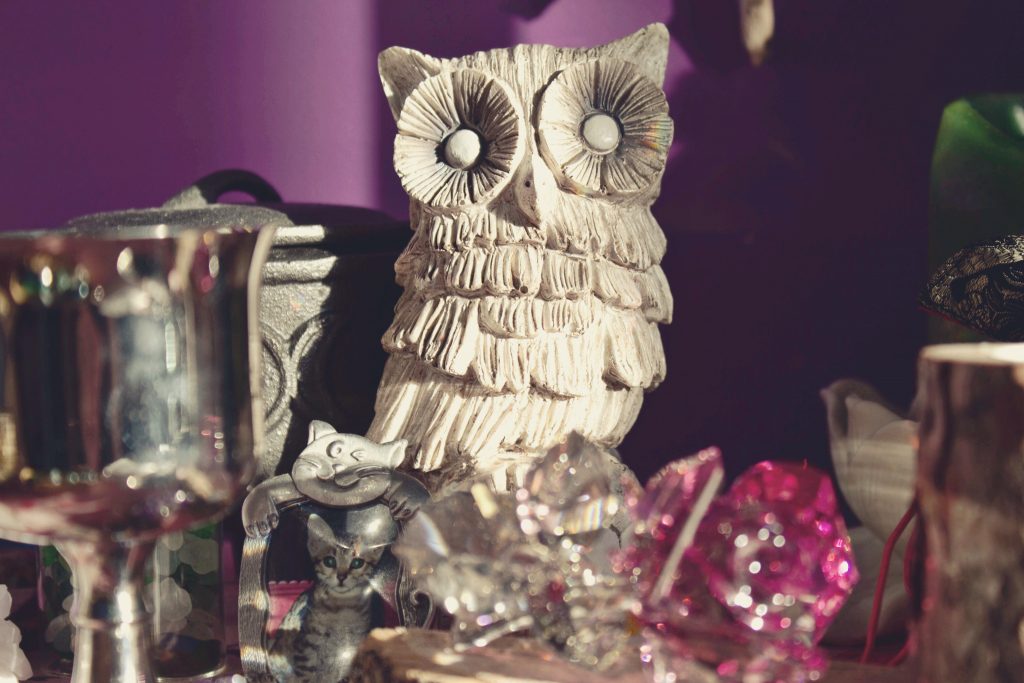
5. Things that Remind You of a Particular Event or Time in Your Life
Think back on events or moments in your life that had a significant impact on you, perhaps a time when you were particularly happy, or a period of significant spiritual growth. Do you have any mementos or material reminders of that time that you might want to include on your altar?
Perhaps something from a time of hardship or struggle that reminds you of your inner strength and resilience? Or maybe something that reminds you of a joyful, transformative moment, such as your wedding day or the birth of your first child. Even if it’s just something like a wristband from a an amazing festival you attended last summer—you could certainly include it on your altar as a representation of the effect it had on you.
Objects are powerful in their ability to store memories and evoke emotions. I believe that material things that make you feel a certain way can be just as meaningful in ritual and witchcraft as those that represent ideas and concepts, such as religious symbols or imagery. Don’t overlook the power of emotion in magick, and don’t underestimate the power of objects to evoke it.
6. Toys from Your Childhood
If you still have any toys or tangible reminders of your childhood (or even if you have some from your own kids that they might let you borrow), including them on your altar can be a fun way to connect with your inner child and explore your imaginative and playful side.
Witchcraft and Paganism are so far from just being about all-black clothing and serious rituals—you should be able to have fun with them! Witchcraft is something that requires an active imagination, so why not celebrate this by including toys and other playful elements into your sacred space?
7. Artwork and Crafts
I think it’s wonderful to be able to include things that you’ve actually made yourself onto your altar, particularly if they were infused with an intention through the process of creation. I’m a strong believer that creativity, magick, and art go hand-in-hand, and often overlap with one another. Even if you’re no Picasso or not especially crafty, even including something like a handmade pentacle or a simple sketch of the sun and moon can give your altar a nice personal touch.
Creating mandalas and sacred/magical symbols out of flowers, crystals, or other materials can also be very meditative and spiritually grounding, and can make a great semi-permanent or temporary addition to your altar.
8. Popular Culture References
Your altar needn’t only house things that are traditionally “Pagan” or adhere to a “witchy” aesthetic. If there are things from pop-culture that stand out to you, or that have been somehow influential to your spiritual growth, then go right ahead and include them on your altar! Hang paintings and photographs you love above your altar, stack it with important books and albums, and make room for representations of musicians, actors, superheroes, and other fictional characters or public figures that have had an impact on your life in one way or another.
We live in a world where we’re constantly surrounded by facets of popular culture, and for many of us, these images, sounds, narratives, and icons often leave a lasting impression, playing a role in our personal development and shaping the ways in which we see the world.
For me, Pink Floyd’s music has played a hugely transformative role in my life, radically altering how I relate to myself and society. For that reason, Pink Floyd posters, album covers, and other memorabilia will likely always be an important aspect of my sacred space. Likewise, someone else might choose to have a magazine cut-out of Hilary Clinton on their altar because of her impact on modern feminism, or a Spider Man action figure because of the values he represents. Again, the options here are essentially limitless!
9. Representations of What You Want to Manifest
Keeping representations of the things you hope to manifest in your life on your altar is a great way to focus on those goals, and open yourself up to receiving that which you want.
For example, if you want to manifest more cash, keep a five dollar bill or a jar of coins on your altar to help you get there. If you want a new car, get a little toy car for your altar to act as your object of focus. Including these kinds of things in your sacred space can serve as helpful reminders to keep you on track while working towards those goals.
10. Materials from Past Spells or Rituals
Even though many witches like to dispose spell materials shortly after they’re done with them, it can sometimes be beneficial to hang onto these bits and pieces. For instance, if you performed a spell that went well and seemed to yield the results you were hoping for, you may want to keep some of the material components from that working on your altar as a reminder of your own magickal power. This can be especially helpful for if you’ve ever experienced a period of frustration or disillusionment with your craft, or felt like nothing is going right.
Spell jars or spell bags that contain material components used in effective spells can be great for this, and I actually keep a small vial of bathwater from a ritual that I found to be particularly powerful on my own altar. It reminds me of the power that I have to control outcomes and shape the course of events in my own life, and that, as a witch, I can do anything.
11. Seasonal Decorations
Finally, while there are lots of things that I keep on my altar year-round, I also enjoy switching things up and redecorating with the turning of the Wheel of the Year. As Glenys Livingstone puts it in her book PaGaian Cosmology, the process of taking down and setting up one’s altar as the as the seasons pass is an inherently artistic endeavour that reflects the Earth’s natural cycles of creativity and destruction.
Just as the items that you choose to include on your altar may be a reflection of inner and outer realities—your understanding of yourself and the cosmos—this process of creation, destruction, and recreation also mirrors the nature of our Universe. The act of decorating your altar can therefore be a means of materialzing your connection to the Earth as it undergoes various transformations, not only because of the seasonal elements you may include, but because of your participation in that cycle.
While some Pagans and witches choose not to redecorate their altars with the seasons, personally I love changing up my sacred space as the Earth around me undergoes these transformations. This process is one of the main ways I prepare for and celebrate the Sabbats on the Wheel of the Year.
Of course, there are plenty of correspondences associated with each Sabbat that you can incorporate onto your altar, such as particular foliage, herbs, and crystals, but this also presents a good opportunity for you to consider what you personally associate with the season. As always, the more personally meaningful, the more spiritually powerful, and the more empowering for your magick.
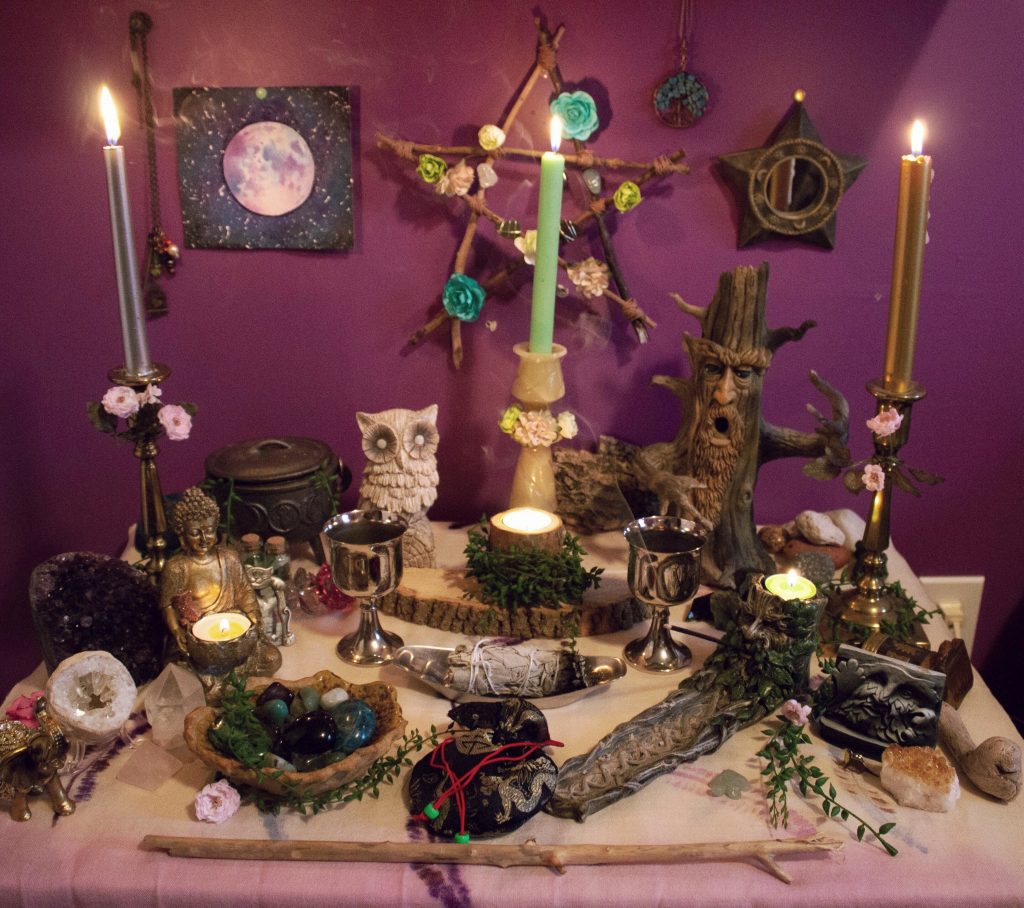
Altar Tours
You can check out my own altar tour on YouTube here:
If you enjoyed this post or found it helpful at all, then I would also highly recommend checking out these altar tours from some of my favourite Pagan/witchy YouTubers.
They have some great ideas for altar design and non-traditional things to include that are not confined to the Wiccan model, and hopefully can provide some inspiration for your own altars!
- Kelly-Ann Maddox’s wonderfully witchy & wacky altars
- Áine Órga’s beautiful, simple Pagan altar
- Molly Robert’s playful, colourful altar
- Owlvine Green’s gorgeous altar and sacred space
Thanks for reading! Let me know in the comments what kinds of nontraditional things you like to incorporate onto your altars!
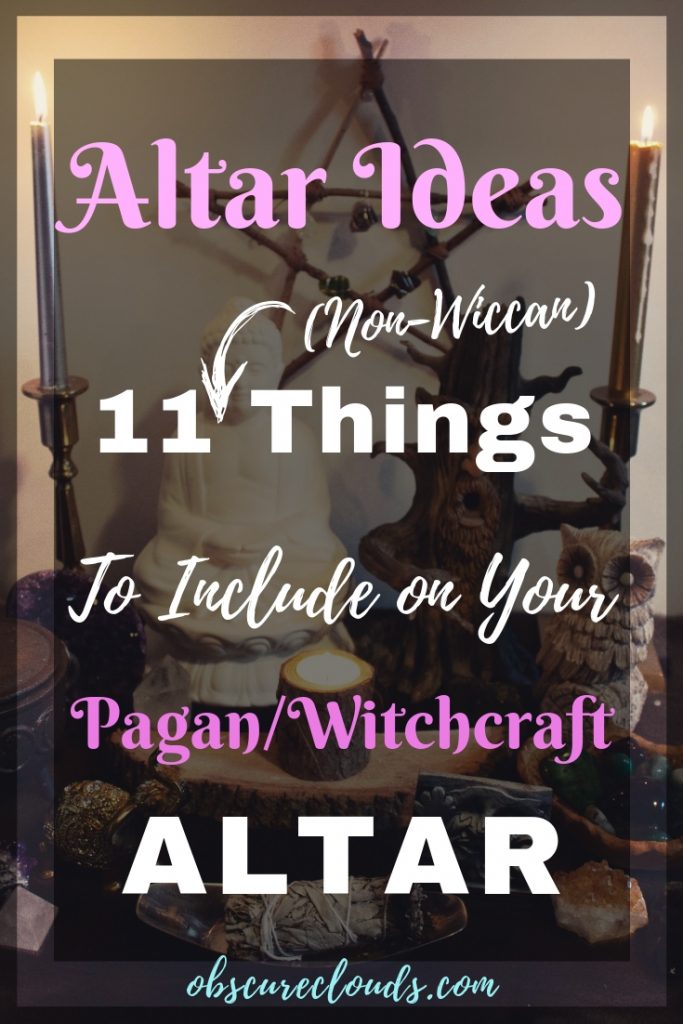

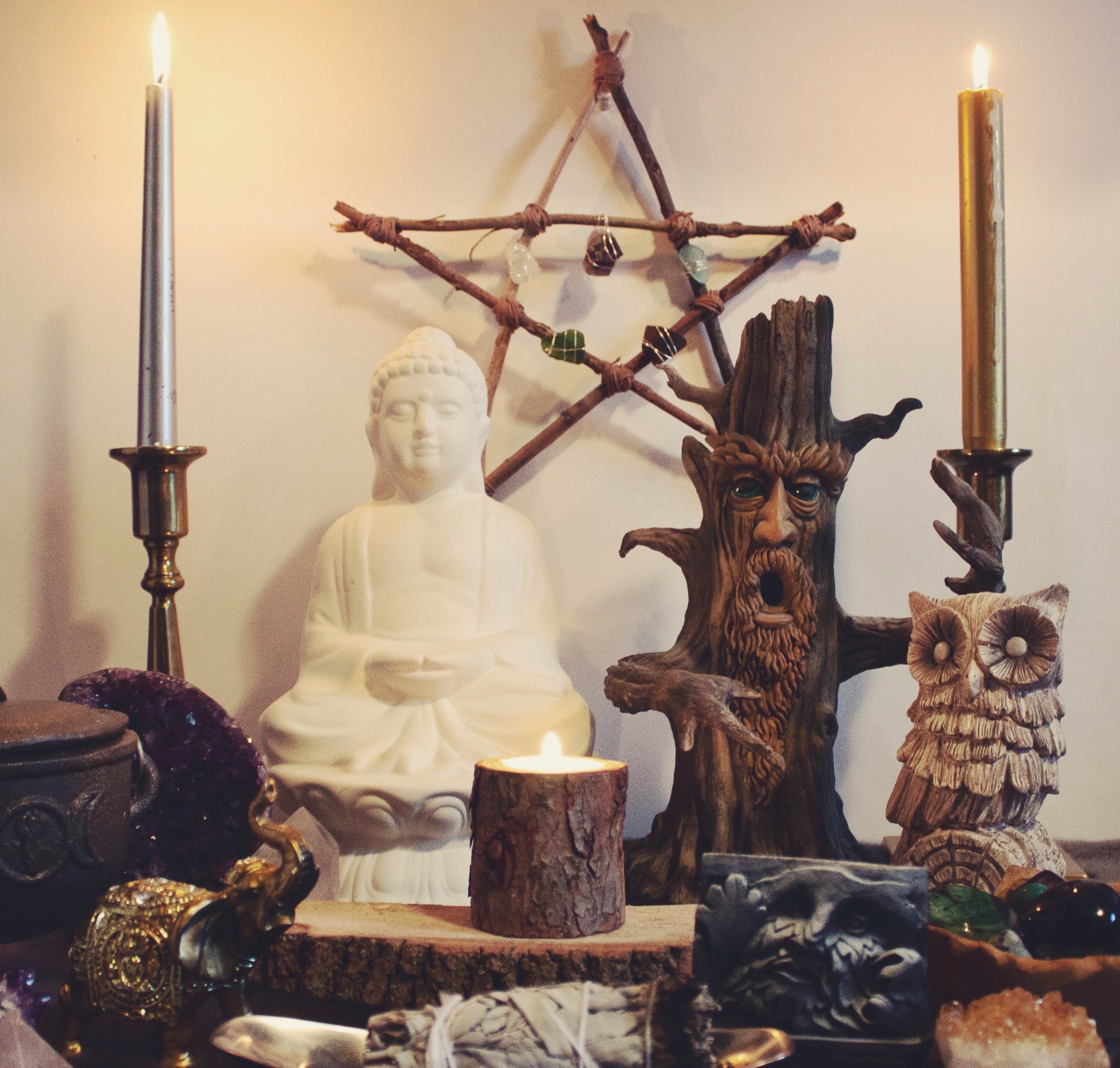

I love this idea, I have been stuck with the traditional Wiccan set up because that was how I was taught when first starting out. I no longer consider myself Wiccan so a lot of things on my altar are basically taking up space. I will definitely be thinking about what you have written and start changing things up.
That’s great, I’m glad this post was helpful for you! I was in the same place for a while where I had a lot of things on there that just didn’t mean anything to me any more… Realizing I could move past the Wiccan set up was really great for me 😊
Your altar is stunning. Plus one on the Pink Floyd shoutout! Shine on you crazy diamond 💎 Lots of great tips in your article that I wasn’t even aware I was already practicing. Happy Beltane (almost). Blessed Be 🤘🏻